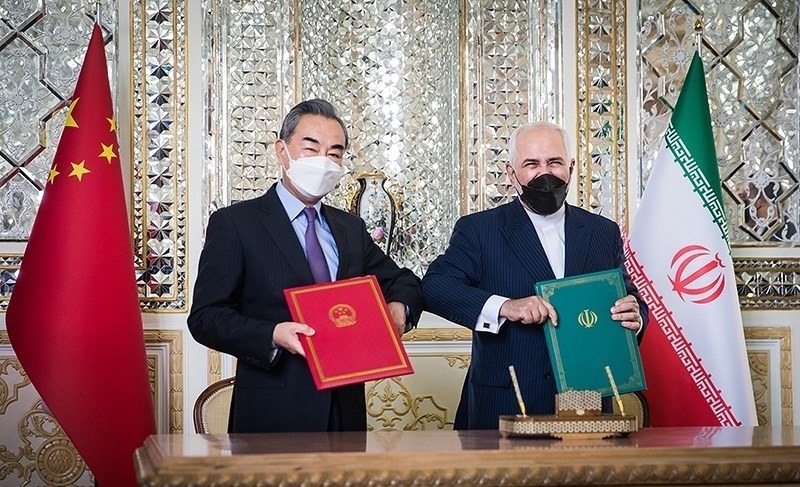A new article in the journal’s spring issue explains how Tehran is looking to utilize the Middle East’s changing power dynamics to its advantage.
A new round of US sanctions on Iran may be coming, warned White House National Security spokesman John Kirby, should the state follow through on new arms sales to Russia to support the Kremlin in its war in Ukraine. The cautioning came amid reports that Tehran has sent ballistic missiles to its partner in recent weeks, a step up from previous shipments of drones and other technology and another escalation in tensions with the United States that have been building for years.
The Islamic Republic has also continued to build its relationship with China, announcing plans for a joint naval exercise next month after cooperating on a similar event in March of 2023. The exercise could be seen as an attempt by China to show force in response to Houthi rebels targeting international shipping lanes since the war in Gaza began. Beijing had previously pressured Iran to help stop attacks or risk jeopardizing economic ties between the two countries.
This growing separation from the US and gravitating toward China and Russia is the result of a change in Iran’s strategic calculus, says Sara Bazoobandi, Marie Curie Fellow at the Institute for Middle East Studies at the German Institute for Global and Area Studies. In an article in Middle East Policy’s new issue, she explains that the changing relationship between the superpowers, from engagement to competition, has “emboldened Tehran’s attempt” to pursue stronger ties with China, revise its strategy toward the Gulf, and project power by showcasing its military capabilities, specifically in the war in Ukraine.
Prominent officials in Iran have “stated that they foresee a new international order to replace the US-led unipolar system.” China’s growing interest in the region, seen in its brokering of the Iran-Saudi Arabia normalization deal and trade with the Gulf Cooperation Council to the tune of $229 billion in 2021, coupled with the perception of US withdrawal, has inspired this thinking.
“Against that backdrop, the Islamic Republic is…motivated to be a member of the newly emerging realm of influence,” Bazoobandi explains, “one hospitable to its own vision.”
China has been Tehran’s biggest trading partner for the last decade, with billions of dollars in goods exchanged that have allowed Iran to circumvent Western sanctions. While it seeks this economic engagement with Beijing, the state has largely looked to Russia for deeper military ties.
“Russia’s overarching global strategy has been focused increasingly on challenging a unipolar system dominated by the United States,” which “has resonated with political ideologies in Tehran and China,” the scholar writes. It “reflects Tehran’s desire for influence in global and regional systems.” To date, Iran has delivered hundreds of drones to Moscow.
In the ever-changing strategic calculus, “a new global order is emerging” in the eyes of Tehran’s leadership, Bazoobandi concludes. “As US power declines, Iran is seeking every opportunity to emerge as a powerful global player.”
Among the major takeaways readers can find in Sara Bazoobandi’s Middle East Policy article, “Iran’s Strategies in Response To Changes in US-China Relations”:
- Iran has pursued a policy of “looking East” to strengthen ties with China and Russia.
- The shifting relationship between the US and China has caused major changes in Iran’s approach to its foreign policy.
- Tehran is deepening ties with China, revising policies in the Gulf, and looking to project military power in Ukraine.
- The government’s approach is in response to their perception that US hegemony is lessening in favor of a multipolar system, with China as the main challenger.
- Iran has had a long history of relations with China that is largely positive, despite its longstanding “no East, no West” approach.
- China has supported Tehran with managing the nuclear issue, assisting in circumventing sanctions, ending the arms embargo, and providing significant economic support.
- China recognizes Iran’s capability to be a powerful player in its economic initiatives around the globe, including the Belt and Road Initiative, however Western pushback has limited investment.
- Iran and China are also collaborating on technological advancement, including in artificial intelligence and cybersecurity.
- China’s increasing role in the Gulf is encouraging Iran to adjust its approach to its southern neighbors as well.
- The recent years, Chinese diplomatic and economic ties with Saudi Arabia have shown Iran that it may be important in reducing US involvement in the region.
- The normalization agreement signed in 2023 has reduced hostilities between Tehran and Riyadh, with hopes for further cooperation as Iran has indicated interest in normalizing relations with the Gulf Cooperation Council.
- An Iran-Saudi deal with Chinese involvement would create significant economic gains for both parties and show that the West is losing its monopoly on shaping regional dynamics.
- Iran has also seen opportunity in US-Russia tensions, particularly on a potential role in the war in Ukraine: Tehran has delivered hundreds of drones to Russia and signaled its willingness to cooperate on military affairs.
- Cooperation with China and Russia reflects continued commitment to the creation of an “Axis of Resistance” through strategic relations and a “security community and ideational network.”
- The recent conflict in Gaza has only further encouraged Iran to embrace the crises that build on its rhetoric of Muslim oppression by the West and stray further towards the East.
You can read “Iran’s Strategies in Response To Changes in US-China Relations” by Sara Bazoobandi in the Spring 2024 issue of Middle East Policy.
(Banner image: Tasnim News Agency)
